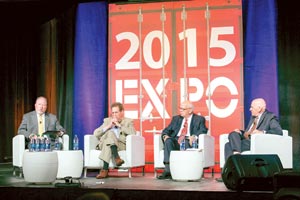Intermodal Cargo Market Growth Shifts as International Accelerates, Experts Say

FORT LAUDERDALE, Fla. — International freight has re-emerged as the driving force for intermodal growth because factors such as lower diesel prices and suboptimal rail service have slowed increases in domestic truck-rail freight, experts said.
“Domestic intermodal growth is very low by recent standards,” Larry Gross, senior consultant at FTR, said at the Intermodal Expo here last week. He cited an increase last month of about 1% in domestic truck-rail freight compared with a 6.3% increase in international intermodal.
A stronger dollar has encouraged imports and sustained international intermodal growth since a snapback in cargo flow in the months after the end of West Coast port disruptions that trimmed cargo volumes earlier this year.
The August numbers indicate that international growth has extended beyond the spring.
Gross is forecasting faster growth in international cargo relative to domestic intermodal for the rest of the year, with import and export cargo increasing 2 percentage points faster than domestic intermodal. That pattern could continue next year, but with a smaller gap between the categories of intermodal freight.
Until the recent turnabout, domestic intermodal had outpaced international cargo because truck-rail attracted freight from highways. As a result, domestic intermodal over the past several years has grown about twice as fast as international cargo.
“We are not seeing folks defect” to intermodal from trucks, Gross said, citing two reasons that have hurt truck-rail offerings.
“Intermodal service and pricing have come under a lot of pressure,” he said, limiting the appeal of the service at a time when diesel price reductions are helping longhaul fleets.
Rail service is another issue that is holding back intermodal, said analysts Thom Albrecht of BB&T Capital Markets and John Larkin of Stifel Nicolaus.
“It all boils down to service,” Larkin said. “That is the hurdle the railroads have to get over.”
Rail intermodal doesn’t have to match 99% on-time levels offered by truckers, he said, but it has to resemble truck service levels, in the 95% on-time range on a consistent basis. For the past 18 months, service hasn’t been at that level, though it has improved overall this year.
“The railroads are serious about improving their service,” Larkin added.
Albrecht emphasized the importance of rail service to 2016 domestic intermodal growth.
Railroads have some other adjustments to make, unique to their service network, as rail bulk traffic such as coal has dwindled with no immediate sign it will recover due to low natural-gas prices and other factors, the analysts said.
“Intermodal has always been the growth story,” said Tony Hatch, who heads ABH Consulting. “What they have to do is pivot because the base business of this industry has changed. Taking up service and taking up rates is the only answer they have” to boost profits and offset lost business.
Larkin agreed: “At the end of the day, the railroads have some heavy lifting to do to maintain their profit margins.”
It will be especially tricky for Eastern railroads that have to face questions about trimming back their coal freight networks, he said.
Noel Perry, managing director at FTR, told attendees the current market conditions won’t continue too much longer.
Perry said the advent of regulatory changes such as electronic logging devices will lead to a record level driver shortage in as little as two years as some drivers’ hours are curtailed.
Other changes such as hair testing for drug use also will cull drivers, he said.
The result, he said, could be more opportunities for intermodal for a few years.
However, Perry also said that intermodal faces a longer-term threat stemming from automation such as platooning that could help truckers lower their costs and neutralize the existing intermodal advantages of lower longhaul rail costs.
“Automation is a huge threat to your [intermodal] business,” he said, citing steps such as platooning that could lower fleet costs and ease driver requirements. “You have to figure out how to be early adopters.”
In contrast to all the shifts and influences on intermodal markets, the underlying economy for the rest of the year and next is going to continue along a familiar slow-growth pace that has been seen for six years, said William Strauss, senior economist for the Federal Reserve Bank of Chicago.
“It is an economy that is more of a tortoise type — slow and steady,” Strauss said.

